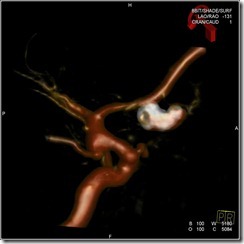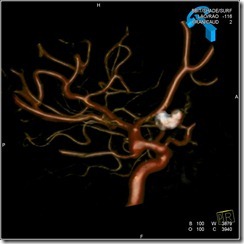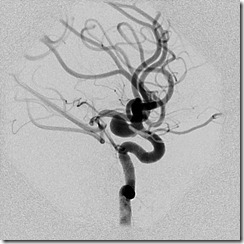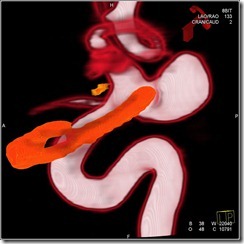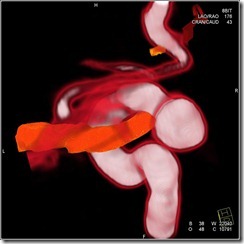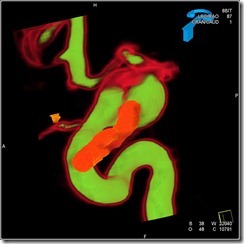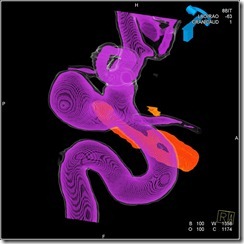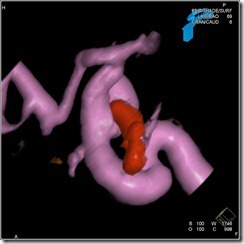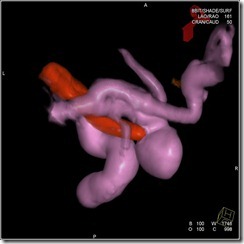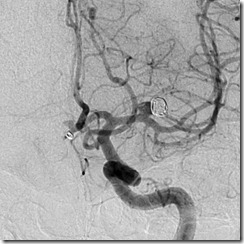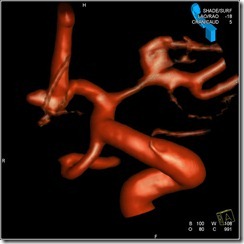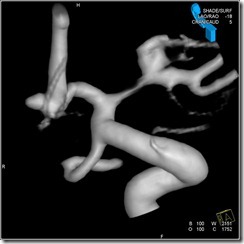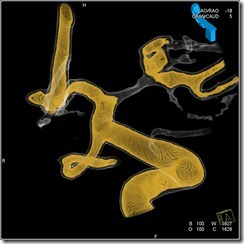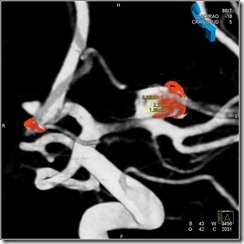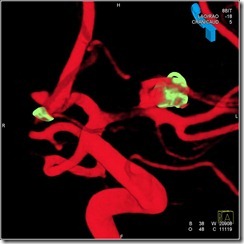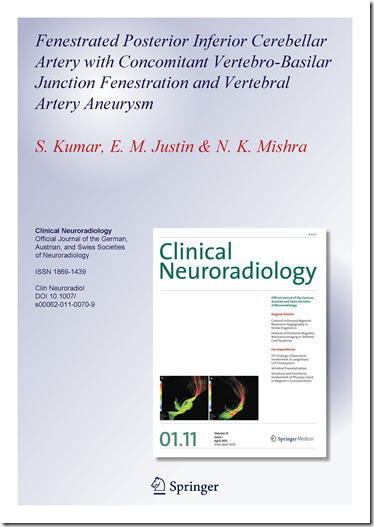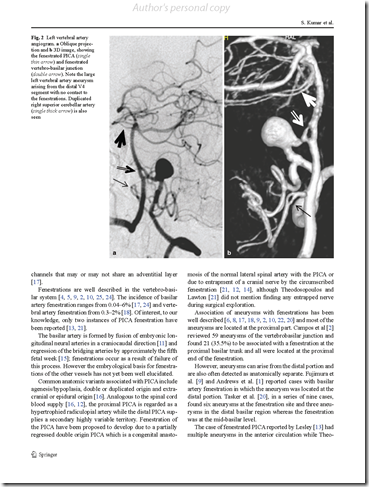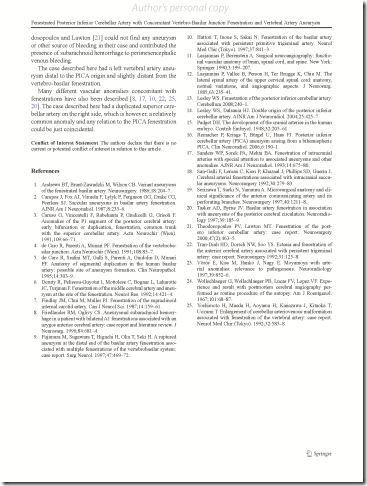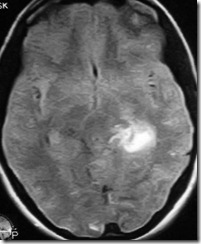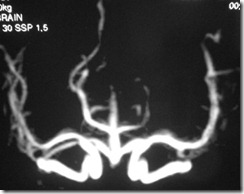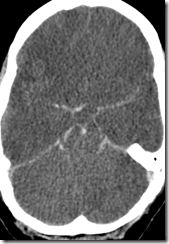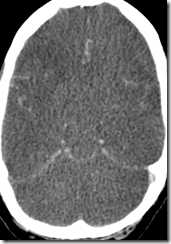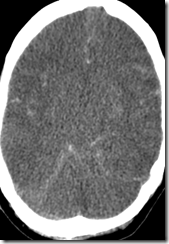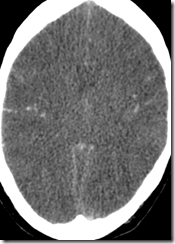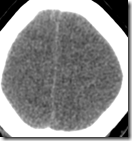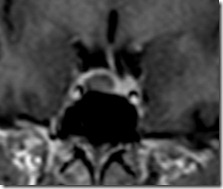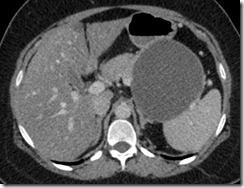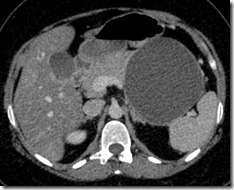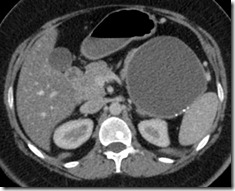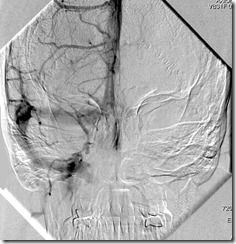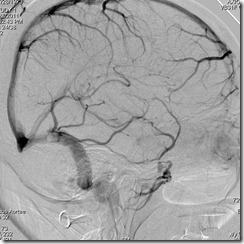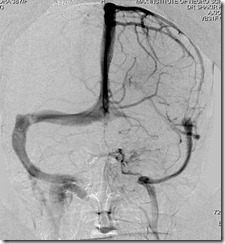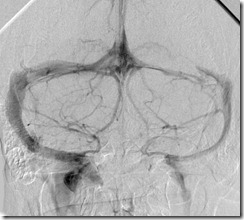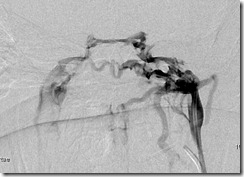dual volume reconstruction from 3d rotational dsa
We all know the significance of 3D views in angiographic evaluation, whether it be CTA, MRA or DSA.
3D DSA provides the best quality images of course, because of the superior spatial resolution, contrast resolution, selective vessel catheterisation, high contrast densities achieved etc. It has been used extensively and is now indispensable, in fact, a must for patients undergoing evaluation of aneurysms.
However, all these techniques have limitations when it comes to evaluation of the follow up imaging of clipped or coiled aneurysms.
CTA is OK for clipped aneurysms but not for coiled ones while CE-MRA hold good for the opposite.
3D DSA can also be marred by the artefacts. In fact, 2D DSA runs often are the best!. However, the recent advancements in the 3D reconstruction technology have made things easier.
Now we have 3d road mapping, fusion DSA, DynaCT etc. A noticeable one is the dual volume reconstruction in which the two acquired data volumes (the mask run and the contrast run) are reconstructed separately and then fused together, with each volume being modifiable individually to give the desired contrast, windowing and colour coding.
Illustrative examples:
Case 1: Immediate post coiling 3D angiogram to look for residue
Post coiling 3D angiogram with dual volume recon on an Acom aneurysm showing the coil mass in silver and the contrast filled arteries in golden brown. The aneurysm is well coiled with no residue. However the base of the coil mass is irregular indicating freshly done procedure. With time, base is likely to be covered up with endothelium and the arterial outline would become smooth.
Case 2: 2D and 3D angiograms in a post clipping regrown aneurysm
Routine angiograms showing a ventral ICA aneurysm with a surgical clip overlying the neck region. The exact relation ship of the clip with the aneurysm and the parent vessel is impossible to make out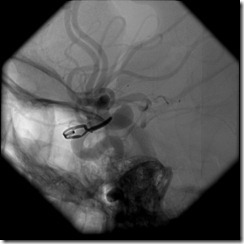
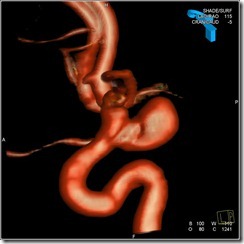
Routine DSA image native view showing the clip and the arterial tree in relation to the bones.
3D run volume rendered image showing the aneurysm and the parent artery well with excellent depiction of the aneurysm morphology. However the clip is not seen as it has got subtracted. Note however that there is a groove over the neck of the aneurysm.
Dual volume reconstruction images with dual colour coding showing the clip and the aneurysm with their interrelationship very nicely. the clip is totally free for the parent vessel and is abutting a very small portion of the aneurysm. It should be relatively easy to coil this aneurysm.
Case 3: Angiogram in a case of previously coiled Acom and left MCA aneurysms
2D DSA and 3D DSA run with volume rendering showing coiled left MCA and Acom aneurysms. There are contrast filled outpouchings seen at both locations again. However, it is difficult to evaluate the aneurysms, parent arteries and the coil mass inter-relationship. We do not know whether these are regrown aneurysms or new ones adjacent to the previously coiled ones.
Dual volume images show clearly that the MCA aneurysm has regrown and a fresh 'kissing’ aneurysm has come up at Acom adjacent to the previous one. clear visualisation of the parent artery, the arterial branches, aneurysm neck and the coil mass is apparent .
Fenestrated Posterior Inferior Cerebellar Artery with Concomitant Vertebro-Basilar Junction Fenestration and Vertebral Artery Aneurysm
My recently published paper
S. Kumar, E. M. Justin & N. K. Mishra. Fenestrated Posterior Inferior Cerebellar Artery with Concomitant Vertebro-Basilar Junction Fenestration and Vertebral Artery Aneurysm. Clin Neuroradiol DOI 10.1007/s00062-011-0070-9
Download from
Spontaneous occlusion of posterior cerebral artery dissecting aneurysm
An young woman from an undeprivileged country had sudden onset severe headache followed by repeated vomitings, transient loss of consciousness. A CT head was done… unfortunately a contrast study… which showed a rounded contrast filled structure in left ambient cistern.
An MRI was subsequently performed after 2 days which showed hyperintensity in the left medial temporal lobe. An MRA showed poor visualisation of left PCA and was otherwise unremarkable.
She was put on antitubercular drugs!
She then landed up with us. A diagnosis of aneurysm was made and an DSA done.
the aneurysm had disappeared. There was cutoff of the left PCA after the ambient segment. Retrograde filling of the entire left PCA territory was however noted via collaterals from left MCA.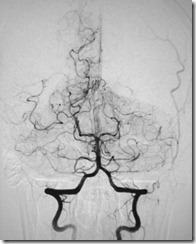
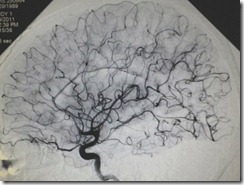
She was now asymptomatic and was sent back home with the advice of a follow up angiogram after 3 months.
PCA dissecting aneurysms are a distinct form of vascular lesions, usually occurring at the P2 segment and have variable clinical presentation.
They have however relatively good outcome as compared to other intracranial aneurysms.
Many of then undergo spontaneous healing, as in our patient (although the PCA had got occluded too), and it is not a bad idea to just observe them.
However, with the advent of modern endovascular techniques, coiling is a feasible option.
Coiling however usually means sacrificing the artery with variable resulting deficits (usually not disabling).
MCA to PCA collateral flow most of the times is able to perfuse the PCA territory adequately, however the patient must be told of deficits, chiefly vision problems.
pseudo subarachnoid hemorrhage on ncct head
A known case of right frontal tuberculoma, on treatment, had seizures, went into status and had to be intubated. Later, patient was found to have bradycardia and non reacting pupils. A CT scan was done.
CT showed swollen brain, loss of gray white differentiation, compression of CSF spaces. And most strikingly, sulcal and cisternal hyperdensity. Looks like SAH!. But it is not. Look at the dural sinuses, they are hyperdense as well. This is a case of ‘pseudo SAH’ appearance due to stagnant flow in the arteries and veins.
Inferior petrosal sinus sampling in men1
A 38 years old female presented with increasing fatigue, weight gain, hyperpigmentation and increasing hairs since 9 months.
She had hypercortisolism.
MR brain showed a 12 mm sized adenoma on right side of anterior pituitary.
CT abdomen shows a large cystic pancreatic mass with specks of wall calcification.
PET (not shown) had shown a ‘Hot spot’ in duodenum.
Dexamethasone suppression test was inconclusive (suppressed with high dose, not suppressed with low dose).
She was hence taken up for inferior petrosal sinus(IPS) sampling.
Right ICA injection AP and Lateral views did not show filing of right IPS. In fact the cavernous sinus also is minimally seen.
Left ICA injection AP and lateral views did show the left IPS.
Now there was a dilemma…
the adenoma was on the right side, and the right IPS was not seen….so what to do?
A vertebral artery injection was taken which did show both IPS. Sometimes the IPS drainage does get disconnected from the cerebral hemispheres and drains the posterior fossa via the petrosal vein.
A 5F catheter was navigated into the jugular vein and thence into the left IPS.
Venogram showed well the left IPS, left cavernous sinus. And as expected, a moderately forceful injection also filled the opposite cavernous sinus and with good reflux down the right IPS. What luck!
So we navigated another catheter (4F this time) into the right IPS and took samples as required.
three pairs of simultaneously drawn samples were sent to the laboratory along with a peripheral venous sample and a right femoral vein sample.
And as expected, ACTH values from right IPS were > 3 times of the left IPS.
The patient was sent for pituitary adenoma surgery.



